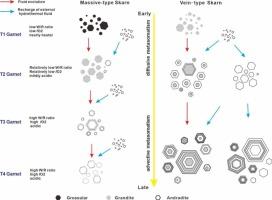西藏甲玛巨型矽卡岩矿床多脉冲流体演化及找矿潜力:来自石榴石地球化学的证据
IF 3.6
2区 地球科学
Q1 GEOLOGY
引用次数: 0
摘要
嘉玛矿床位于西藏,是目前国内最大的矽卡岩型铜多金属矿床,主要赋存于临步宗组与多地沟组之间的构造带内。甲玛矿床的重要性近年来吸引了许多研究者对其矿物组成、分带及其与矿化关系的研究。然而,这些研究都主张基于石榴石颜色变化的演化过程来表征不同矽卡岩类型的热液流体。这种方法可能留下一些关键问题没有解决,例如不同构造类型夕卡岩中流体演化的不同特征,这些流体是如何演化的,以及演化和成矿过程是如何发生的。为了解决这些问题,我们采用不同结构石榴石的主微量元素组成分析,旨在揭示矽卡岩中热液流体的演化和不同结构石榴石的形成。岩石学、EPMA和LA-ICP-MS分析表明,甲玛夕卡岩具有从近端透辉-石榴石夕卡岩向远端石榴石-硅灰岩夕卡岩过渡的特征,石榴石类型由粗晶型向以辐射型为主演变。结果表明,块状矽卡岩中T1石榴石表现出重稀土元素富集、轻稀土元素亏缺的特征,T2石榴石表现出轻稀土元素与重稀土元素之间的弱分异,但均表现出负铕异常。T3和T4石榴石与前两种类型明显不同,呈现右倾形态,并伴有明显的Eu阳性异常。脉状石榴石稀土元素模式较为复杂,可分为3种类型:(1)完全左倾型(LREE/HREE = 0.40 ~ 0.46),具有明显的Eu负异常;(2)近扁平型(LREE/HREE = 2.10 ~ 4.86),几乎不存在Eu异常;(3) LREE/HREE = 2.98 ~ 48.11,低重稀土(LREE)富集、低重稀土(HREE)亏缺型,无或弱Eu正异常。稀土元素模式和共生关系表明,早期的相对封闭、中性、低fo2、扩散为主的交代阶段,随后流体流入到开放、酸性、高fo2、平流为主的环境中,脉状石榴石的组成和稀土元素变化也证明了这一转变。脉型石榴石特征的这些显著差异反映了其形成过程中流体物理化学性质(如pH值、氧化还原状态、流体成分)的显著变化。甲玛矿床石榴石的地球化学特征表明,夕卡岩形成流体经历了多阶段的演化,脉状石榴石的成分变化显著。考虑到我们最近的矽卡岩样品中含有钨(W),这些结果可能意味着富W的安长石石榴石经常被后来的矿物所取代,这一过程将W从石榴石释放到流体中,随后在有利的条件下,W可能在流体中浓缩形成矿床。本文章由计算机程序翻译,如有差异,请以英文原文为准。

Multipulsed fluid evolution and tungsten prospecting potential of the giant Jiama skarn deposit, Tibet: Evidence from garnet geochemistry
The Jiama deposit, located in Tibet and recognized as the largest skarn-type Cu-polymetallic deposit in China, primarily hosts skarn orebodies within the structural zone between the Linbuzong Formation and Duodigou Formation. The importance of Jiama deposit has racently attracted many researchers on the studies of mineral composition, zoning, and the relationship with mineralization of the skarn. However, these studies argue for the evolution process based on garnet color variations to characterize the hydrothermal fluids of different skarn types. This approach may leave several critical questions unaddressed, such as the distinct features of fluid evolution in skarns with different structural types, how these fluids evolved, and how the evolution and ore-forming processes occurred. To address such problems, we adopt the major/trace elements composition analysis of garnets with different structures that aim to revealing the evolution of hydrothermal fliuds and the formation garnets of different structures in skarns. In specific, the Jiama skarn is characterized by a transition from proximal diopside-garnet skarn to distal garnet-wollastonite skarn, with four garnet types evolving from grossular to dominantly andraditic compositions as shown by petrography, EPMA, and LA-ICP-MS analyses. The results show that, T1 garnet in massive skarn exhibits enrichment in heavy rare earth elements (HREEs) and depletion in light rare earth elements (LREEs), T2 garnet shows weak fractionation between LREEs and HREEs, but both display negative Europium (Eu) anomalies. T3 and T4 garnets are distinctly different from the former types, exhibiting right-leaning patterns accompanied by pronounced positive Eu anomalies. The rare earth element (REE) patterns of vein-type garnets are more complex, and can be classified into three types: (1) Completely left-leaning type (LREE/HREE = 0.40–0.46) with distinct negative Eu anomalies; (2)Nearly flat type (LREE/HREE = 2.10–4.86) with almost no Eu anomaly; (3) Type with slight enrichment in LREEs and depletion in HREEs (LREE/HREE = 2.98–48.11), exhibiting no or weak positive Eu anomalies. REE patterns and paragenetic relationships indicate an early, relatively closed, neutral, low-fO2, diffusion-dominated metasomatic stage followed by later fluid influx into an open, acidic, high-fO2, advection-dominated environment, a shift also evidenced by compositional and REE variations in vein-type garnets. These significant differences in vein-type garnet features reflect significant changes in fluid physicochemical properties (e.g., pH, redox state, fluid composition) during their formation. It also shows that the geochemical characteristics of garnets in the Jiama deposit indicate a multi-stage evolution of skarn-forming fluids and the compositional variations in vein-type garnets are significant. Considering that in our recent skarn samples with a content of tungsten (W), these reulsts may imply that W-rich andradite garnets are often replaced by later minerals, a process that releases W from the garnet into the fluid, where it may subsequently concentrate to form ore deposits under favorable conditions.
求助全文
通过发布文献求助,成功后即可免费获取论文全文。
去求助
来源期刊

Ore Geology Reviews
地学-地质学
CiteScore
6.50
自引率
27.30%
发文量
546
审稿时长
22.9 weeks
期刊介绍:
Ore Geology Reviews aims to familiarize all earth scientists with recent advances in a number of interconnected disciplines related to the study of, and search for, ore deposits. The reviews range from brief to longer contributions, but the journal preferentially publishes manuscripts that fill the niche between the commonly shorter journal articles and the comprehensive book coverages, and thus has a special appeal to many authors and readers.
 求助内容:
求助内容: 应助结果提醒方式:
应助结果提醒方式:


